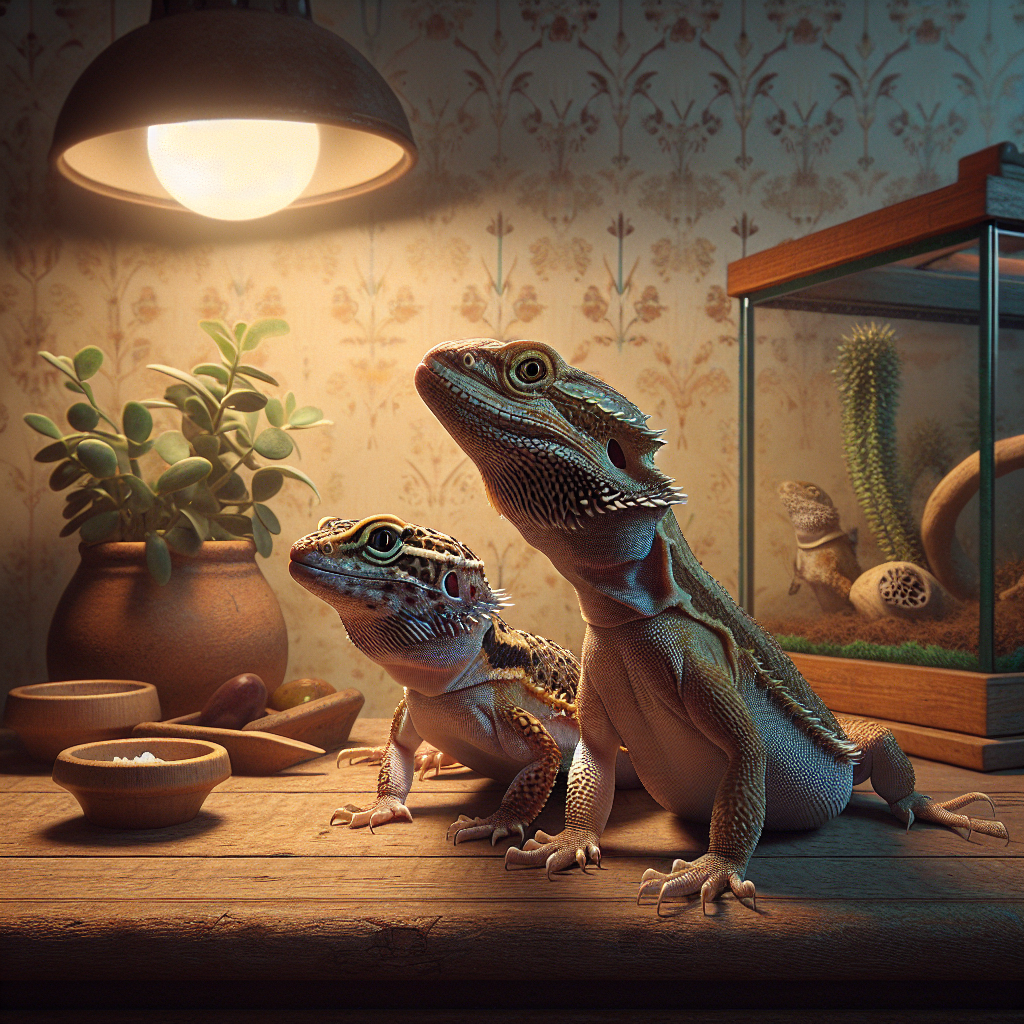Have you ever watched a child light up with excitement, face pressed against the glass of a reptile exhibit, eyes wide in awe? It’s a scene many parents know well—a magical moment when curiosity about the animal kingdom sparks. If you’re considering transforming that wonder into a family hobby, you’re in the right place. Welcome to the world of family friendly lizards, where scales meet smiles and where every family can become intrepid explorers from the comfort of their home.
Jumping into any new adventure, especially one with cold-blooded companions, can feel a bit daunting. How do you know which lizard species are best suited for family life? What do they eat? How do you ensure they’re happy and healthy? These questions might be swirling in your mind, and that's perfectly okay. It's a lot to take in, and it’s easy to feel overwhelmed. But fear not—that’s exactly why this guide exists.
Think of this guide as your map and compass, ready to lead you through this intriguing journey. Start by unraveling the basics of reptilian companionship with family-friendly lizards. Discover how to create the perfect home for your new scaly friend, and gain confidence as you learn to meet their nutritional needs. Handling and bonding tips will soon transform lizard watch-times into cherished family moments. Plus, handy advice on common health issues will ensure you're well-prepared to offer the best care.
Each chuckle, each awe-inspired gaze, each new discovery—it’s all bound to enrich your family’s tapestry of experiences. Ready for your scales and tales adventure? Let’s dive in!
Welcome to your ultimate beginner’s guide to Family Friendly Lizards! This guide is designed for families eager to explore the fascinating world of reptiles together. Firstly, you’ll discover how to choose the right lizard species for family life. Secondly, learn to create a comfortable habitat and meet their nutritional needs. By following our tips, you’ll turn lizard care into memorable experiences, making every moment count in your family's new adventure.
Understanding the Basics of Family Friendly Lizards

Remember sitting in the waiting room of the doctor's office as a kid, just dreading that upcoming shot? But then, the doctor comes out with a smile and a gentle manner, making the whole process seem so simple and painless. That's what we're here to do for you today in this journey of learning about family friendly lizards. We've been in your shoes, and we're going to help you navigate through the basics like a pro.
Firstly, let's clear the air – yes, lizards can be family friendly, and they make charming pets. Choosing the right reptile might seem daunting, especially when you're considering your children's safety and interests. Still, like finding that perfect vacation spot, it's all about research, preparation, and finding the right fit.
It's like assembling a jigsaw puzzle—one piece at a time. Your first piece? Understanding what makes a lizard "family friendly." Generally, these fellas are easily handled, have a calm temperament, and require straightforward care. Think of the Bearded Dragon or the Leopard Gecko – both hugely popular due to their docile nature and relatively simple upkeep.
Step two is just as crucial: evaluating your family's lifestyle and ability to commit. Do you often travel? Are you ready for daily feedings and regular veterinary check-ups, just like you'd have to handle for a new puppy? Balancing your family's needs with that of your potential pet is key to this puzzle.
Finally, educate your brood about a future reptile mate. The way kids learn to respect their dog's boundaries, they should understand those of your new lizard. Supervise initial interactions, familiarize the children with dos and don'ts, and above all – underline that a pet is a living being deserving of care and respect.
So, to sum it up: research, consider your lifestyle, and educate your family. Three simple steps to finding your perfect family-friendly lizard. And remember, we're here to lend a helping hand. After all, who said 'easy' and 'adventure' can't go hand in hand?
Stay tuned for more strategies and tips. In the next section, we will dive deeper into different types of family friendly lizards and what makes each one unique. Until then, dream about the memorable encounters and cuddling sessions your family could have with these marvelous, misunderstood creatures.
Take a step today and share with us: which of these steps has been the most thought-provoking for you? Remember, the first step towards accomplishing anything is deciding you will not stay in the same place. Ready to move forward with your scaly friends?
This guide is designed for families considering adding a pet to their household, specifically focusing on Family Friendly Lizards. Understanding that choosing a reptile can feel overwhelming, this article encourages a researched and prepared approach to ensure a good fit.
Firstly, it emphasizes the qualities that make lizards suitable companions, like their gentle nature and ease of care, featuring popular choices like Bearded Dragons and Leopard Geckos. Furthermore, it highlights the importance of evaluating your family's lifestyle and the commitment required for proper care.
Finally, educating children about pet responsibility and respect for these creatures is essential for a successful pet-ownership experience. Therefore, follow the three core steps: research, assess your family's situation, and educate everyone involved. With this foundation, you're on your way to embracing the adventure of raising a family-friendly lizard!
Choosing the Right Lizard Species for Your Family
Just like choosing the perfect holiday destination, choosing the right lizard for your family shouldn't be taken lightly. After all, wouldn’t it be disappointing if your much-awaited family vacation turned out to be less than fantastic just because you all didn't feel up for winter sports? Similarly, not all lizards make good family pets, especially if you are just starting out. So, let’s take one step at a time to pick the best 'family friendly lizards.'
Start by doing your homework. Research different types of lizards and their behaviors. You wouldn't want to jump into an adventure tour without a map, right? For instance, Bearded Dragons, due to their docile nature and manageable size, are often considered the best pet lizards for beginners.
Once you have your list, think logically. Match your lifestyle to a lizard's needs. Write it all down, creating a fun bonding activity for your family, like planning a trip itinerary, but with fun lizard facts! Compared to other reptile pets, Leopard Geckos, for example, require little care and are very interactive, making them a good choice for busy families.
Lastly, take the time to physically encounter different types of lizards. Visit a local pet store or reptile expo, believe me, it’s like going to a mini animal-themed amusement park! Not only does this bring the family together, but it will also give you an insight into each lizard's demeanor, size, and looks. Trust me, there's nothing like finally getting to see the Colosseum after studying about it for so long, right?
So, take your time, engage with the family, and remember, you're on an exploration mission to find the perfect family-friendly lizard. It’s a little nerve-wracking, I know, but hey, the best family adventures usually are! See you in the next section where we will dive deeper, help you understand lizard care, and make sure your pet adapts well to its new home. Can’t wait, can you?
In this beginner's guide to Family Friendly Lizards, we aim to help families choose the right lizard as a pet. Firstly, it's essential to research various lizard types and their behaviors, as not all lizards are suitable for beginners. For example, Bearded Dragons are known for their docile nature and manageable size.
Next, align the lizard's needs with your family’s lifestyle. Interactive options like Leopard Geckos can be ideal for busy households due to their low care requirements. Finally, enhance your selection process by visiting pet stores or expos, allowing your family to engage directly with these fascinating creatures. This step not only promotes bonding but helps everyone understand different lizards' temperaments and characteristics. Take your time through this exciting journey to find the perfect family-friendly lizard!
Setting Up a Comfortable Habitat for Your Lizard
Setting Up a Comfortable Habitat for Your Family-Friendly Lizards
Remember when you arrived at the vacation villa, peeking around to ensure every family member was catered for? Imagine how your new pet lizard might feel stepping into its new home for the first time. It's imperative for their overall health that we create a comfortable space for them.
The first step is choosing the right-sized tank. Think of it as picking a family-friendly hotel room. No one likes being cramped up, our scaly friends included. Depending upon the type of lizard, a 20- to 50-gallon size tank would suffice for most family-friendly lizards.
Ensure this new home mimics their natural habitat. Fill it with clean substrate such as newspaper or reptile carpet—avoid using sand, reminding me, yes me, looking like the abominable snowman during a sandstorm in Egypt— big 'no-no' for our lizard buds.
Decorate the tank with fixtures like branches and rocks for your lizards to bask and exercise, just like how we need a tennis court or swimming pool. Make sure these fixtures are stable—you wouldn’t want a branch collapsing mid-climb. Trust me, it'd be like tripping on a toddler's toy in the middle of the night, only scarier!
Next, let’s talk about temperature. Lizards are cold-blooded and need warmth to digest their food—think of those oh-so-soothing beach holidays. Install a heat lamp, but ensure there's a cooler area in the tank too, just so they can escape if it gets too hot, like finding shade under a palm tree.
Finally, consider appropriate light exposure. UVB light is a must-have for lizards to produce vitamin D3. So, think of these lights as the daily dose of sunshine your family friendly lizards need, even when they are miles away from their natural habitat. What's one bold step you can take today towards creating the perfect habitat for your lizard?
Remember, Rome wasn’t built in a day. Don’t rush in setting up the perfect home for your new pet. It is a process, gradually assembling, just like that jigsaw puzzle you completed on your last family vacation. But with patience and care, you'll create a mini oasis that will make your reptile friend feel right at home.
Summary: Setting Up a Comfortable Habitat for Your Family-Friendly Lizards
This guide aims to help beginners create a welcoming home for family-friendly lizards, ensuring their comfort and health. First, choose an appropriately sized tank, ideally between 20 to 50 gallons, as this space is pivotal for their well-being. Next, mimic their natural habitat with clean substrates and stable decorations like branches and rocks for exercise and basking.
Additionally, maintain proper temperature and light; installing a heat lamp and providing UVB light are essential for digestion and vitamin D3 production. Therefore, take your time setting up this mini oasis, just like piecing together a jigsaw puzzle. With patience and care, your lizard will thrive in its new environment.
Feeding and Nutrition Guidelines for Family Friendly Lizards
Do you remember getting nervous about packing your kid's lunchbox for their first day of school? You wanted it to be nutritious, tasty, and something they'll certainly eat – a culinary challenge, indeed! Now, imagine if your child was a lizard. A family-friendly lizard, to be precise. From what they eat to how often they feed, understanding the basics of lizard nutrition can be just as daunting. But don't worry! I'm here to share simple steps to get you started.
Firstly, build a basic understanding. Research your lizard's species; different kinds of family-friendly lizards have different dietary needs. For instance, some are vegetarians (like an Iguana!), while others need an insect diet (like Bearded Dragons!). Learn about the 'What?' by discovering what particular diet your lizard needs.
Next, comes the 'How often?' Rule of thumb is, younger lizards usually need daily feeding since they're growing. But adult lizards? They're a bit more like us! Three to four meals a week should suffice. However, this might vary based on the species and the lizard's individual health status.
Let's now address the 'How much?' starting with an everyday metaphor – think of it like a mini buffet. Serve a variety of food items in a quantity that your lizard can consume within 15 minutes. Anything beyond that might be excessive.
Lastly, consider nutritional supplements. And no, we're not advancing lizard-gym culture! Certain vitamins and minerals assist vital bodily functions for lizards. So, sprinkle some calcium or vitamin D3 on their food a few times per week. Just remember, it's like adding sugar to your morning coffee – moderation is key.
Feeding and nutrition is a significant part of caring for family-friendly lizards, especially for beginners. So, remember the first time you had to navigate foreign cuisine in a new travel destination? This might feel a touch similar. But in no time, you'll be a pro lizard feeder!
By following these simple guidelines, you can ensure your new reptilian family member thrives in its new home. And you know what? You'll be building your knowledge and expertise, just like you did when you first started traveling with your family.
This guide aims to simplify lizard nutrition for families considering family-friendly lizards as pets. Firstly, it's essential to research your lizard's species, as their dietary needs vary significantly. Some lizards, like Iguanas, are vegetarians, while others, such as Bearded Dragons, thrive on insects.
Next, consider the feeding frequency. Younger lizards require daily feedings, whereas adults typically need meals about three to four times a week. Additionally, understanding portion sizes is crucial—serve a variety of food items that your lizard can finish in about 15 minutes.
Finally, don't overlook nutritional supplements. Adding calcium or vitamin D3 to their diet a few times a week can support their health. Therefore, with these straightforward tips, you'll be well on your way to providing the best care for your family-friendly lizard! In no time, you’ll feel like an expert in lizard nutrition.
Handling and Bonding with Your Family Friendly Lizard
Nudging Into Affinity – Getting Comfortable with Your Family Friendly Lizard
Ever remember trying to make new friends on your first day at a foreign school and the jitters that came with it? Well, bonding with your friendly family lizard can feel pretty much the same. Especially if you're new to this, and despite their petite nature, these lizards can be pretty intimidating, too.
Step 1: Making First Contact
Most family friendly lizards, such as a friendly bearded dragon or a mellow blue-tongued skink, are usually easy to handle. Start by picking them up gently from the belly using a flat, open hand. Resist the urge to grip, as this can scare them. It’s kind of like getting on an elephant ride during a family trip to Bali—awkward at first, but you'll get used to it.
Step 2: Regular Interaction
Now that you’ve clenched the initial awkward situation, make it a habit to interact with your lizard daily. This can be through feeding them by hand or spending quiet time together. Just think of it as becoming their best hotel buddy. The more acquainted you get, the more comfortable your lizard will feel.
Step 3: Taking a Stroll
Finally, allow your lizard some outside-of-the-tank time for exploration. It’s like letting your kid roam freely in a Disneyland park. Monitor their moves and engage with them. But remember—safety first!
Bonding with a pet for the first time can be like trying to map out an unfamiliar city, but one small step at a time, and you’ll soon master it. It's okay to feel unsure. After all, we've all been the new kid in town once, haven't we?
So, how about giving these steps a try and see that fear factor slip away, one friendly lizard at a time? Your newfound bond with your lizard will not only be a fun family pastime but also a gentle nod towards embracing wildlife. Embrace the adventure that comes with bonding with your family friendly lizards today!
The memories you create are just like stamps in your travel passport. Each bonding activity brings you one step closer to becoming a happy lizard family, opening the way to more adventures. Just like navigating a new city, it begins with the first small step. What step will you take today to deepen your bond with your lizard buddy?
Summary: Bonding with Family Friendly Lizards
This guide aims to help beginners connect with their family friendly lizards, such as bearded dragons and blue-tongued skinks. Firstly, start by making gentle first contact to alleviate any fears. Next, engage in regular interaction, like hand-feeding or quiet bonding time, to strengthen your relationship. Lastly, allow your lizard to explore outside of their tank safely.
Therefore, each small step you take brings you closer to a joyful bond. Remember, just like exploring a new city, patience and consistency are key. Embrace this adventure and watch your family bond grow with your friendly lizards!
Common Health Issues and Care Tips for Family Friendly Lizards
Understanding Common Health Issues and Caring for Your Family Friendly Lizards
Imagine the happiness on your kids' faces as they play and bond with their new family-friendly lizard. Yet buried beneath this joy, there's this nagging question: How do I keep this cute creature healthy and safe?
As beginners in lizard care, understanding common health issues can be a real game changer. So let's break it down in easy-to-follow steps.
1. Research Specific Breeds: Different breeds of family-friendly lizards have different health concerns. For instance, Bearded Dragons often suffer from metabolic bone disease if not given enough calcium. Make sure you become an expert on your specific breed.
2. Proper Nutrition: Just like humans, lizards need balanced nutrients to thrive. Ensure their diet includes an assortment of vegetables, fruits, and insects. This reduces the risk of nutritional deficiencies, weakness, or obesity.
3. Proper Habitat: Lizards low in Vitamin D can suffer from Metabolic Bone Disease—an ailment that weakens their bones. A well-lit enclosure with UVB lights helps them synthesize this critical vitamin.
Ever switched your office desk and felt all disoriented? That's how lizards feel too, when their enclosure setup changes abruptly. So, maintain a proper habitat and limit sudden changes.
4. Regular Vet Checkups: Lizards don’t complain about their wounds or aching bellies. Regular vet visits can spot signs of parasites, stress or poor feeding habits early. Remember the time you were relieved to catch a fever early enough. Regular checks can save the day—just like they do for us humans.
With these steps, you'll set the foundation of your journey towards becoming a reliable caretaker for family-friendly lizards. Just remember—in every step, transparency and openness are essential. After all, that's our way of dealing with health issues, isn't it?
In the next section, we'll dive into yet more details about handling family-friendly lizards. Excited? So are we. A whole new lizard world awaits you.
Summary: Caring for Family-Friendly Lizards: A Beginner's Guide
This guide aims to help beginners care for family-friendly lizards while ensuring their health and happiness. Firstly, understanding specific breeds is crucial, as different lizards may face unique health challenges. Therefore, providing a balanced diet and a well-lit habitat is essential for preventing issues like Metabolic Bone Disease.
Moreover, regular veterinary checkups can help identify health concerns early, ensuring your lizard remains safe and stress-free. By following these steps, you can confidently nurture your new family member and enhance the bond with your kids. Get ready to explore the rewarding world of caring for family-friendly lizards!
As you embark on this enriching journey into the world of family-friendly lizards, imagine your first encounter with these charming creatures—much like stepping into a serene garden you’ve only read about. You’ve got the tools, knowledge, and insight to transform your household into a lively ecosystem brimming with discovery and joy. Remember, the thrill of exploring lizard care alongside your family is akin to flipping through a vibrant travel magazine—each page offering new wonders and bonding moments to cherish.
Think of the countless family adventures unfolding in your living room: setting up habitats as intricate as a sandcastle or nurturing your lizard with a balanced diet as lovingly as crafting a Sunday family breakfast. These experiences not only enhance your family's lives but also foster a deep connection with nature. Together, you will develop curiosity, responsibility, and compassion—all treasured values that reptiles quietly ignite.
Now, with the groundwork laid by this guide, it's your moment to dive in. Whether you're examining the perfect lizard species, arranging cozy enclosures, or mastering nutrition, remember: every small step unveils a layer of wisdom and magic in lizard care. So, start your journey today—embrace the adventure, share the smiles, and watch your family’s bond flourish with each new lizard tale you create. Enjoy this new chapter and let your newfound passion for these creatures lead to lifelong memories.
FAQ:
Question: What are some signs that a lizard is suitable for family life?
Family-friendly lizards typically exhibit gentle temperaments, making them great companions for children. Look for species like Bearded Dragons or Leopard Geckos known for their docile nature. Additionally, lizards with low maintenance requirements are ideal for families with busy schedules. By choosing a species that aligns with your family's lifestyle and considering their care needs, you can ensure a harmonious bond with your new reptilian friend.
Question: How can I ensure the comfort of my family-friendly lizard in their habitat?
Creating a comfortable habitat for your family-friendly lizard is crucial for their well-being. Start by selecting an appropriately sized tank with clean substrates and stable decorations for exercise and basking. Maintain a proper temperature range and provide UVB light for digestion and vitamin D3 production. By setting up a habitat that mimics their natural environment, you can ensure your lizard feels secure and content in their new home.
Question: What should I consider when feeding my family-friendly lizard?
When it comes to feeding family-friendly lizards, it's essential to research their species-specific dietary needs. Some lizards, like Bearded Dragons, require a diet rich in insects, while others, like Iguanas, are primarily herbivores. Adjust feeding frequency based on your lizard's age, with younger lizards needing daily meals and adults requiring feeding three to four times a week. Offering a variety of food items in appropriate portion sizes and including nutritional supplements like calcium or vitamin D3 will help support your lizard's overall health.
Question: How can I establish a strong bond with my family-friendly lizard?
Building a strong bond with your family-friendly lizard takes time and patience. Start by making gentle first contact to build trust and alleviate any fears. Engage in regular interactions like hand-feeding and spending quiet bonding time together. Allow your lizard to explore outside of their tank safely to foster positive experiences. By creating a routine of care and interaction, you can strengthen your relationship with your family-friendly lizard and enjoy a rewarding companionship that enhances your family's overall experience with reptile ownership.



